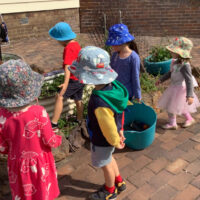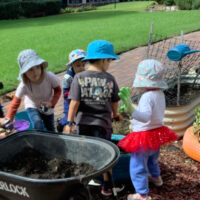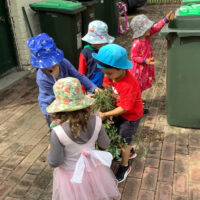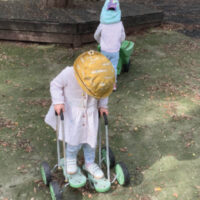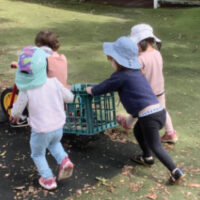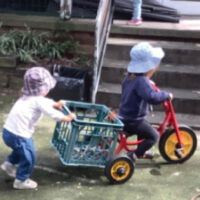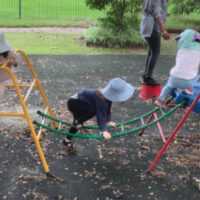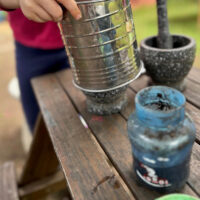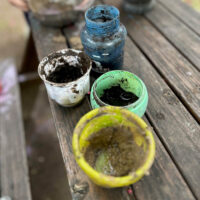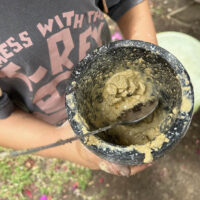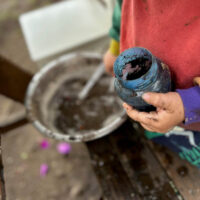Johnson House
Waratah Room
Story by Educator Shelley
Gardening and maintaining the natural environment at Johnson House create some wonderful learning opportunities for the children to learn about sustainability, healthy eating, teamwork and where our food comes from. On a previous nature walk, one child commented that the garden was a bit “messy looking”, which led to a conversation about what we could do to improve it. “We could plant more flowers,” said one child and “We could tidy up,” said another child, which initiated a new gardening project. This week our enthusiastic gardeners helped to clear out a very overgrown garden bed, removing weeds and all sorts of rubbish. The first task was to sort out the weeds from the other plants. The children posed some good questions such as “What are weeds?”, “How do we know if it’s a weed?”, and “Are weeds bad?”. These were such good questions, and they encouraged the children to use their observation skills to sort the weeds from the other plants and flowers.
Through regular gardening experiences and nature walks the children are learning to identify some plant species, including weeds such as Oxalis and Dandelion. And to answer the question ‘are weeds bad’? Well, yes and no. Dandelions are quite pretty and non-threatening, but others, like Oxalis and Bindii, are quite invasive and can quickly overtake the garden, stripping vital nutrients from our other plants. Hence there was a unanimous agreement that the weeds had to go! There was much excitement and some laughs along the way as the children eagerly pulled out the weeds and commented on their findings. “This one has lots of legs,” said one child, referring to the plant’s roots, and “Oh, look there’s lots of ants, are they going to eat our plants?”.
After weeding and turning over the soil we planted some winter vegetables, namely spinach, carrots and lettuce. Not everyone agreed on the spinach though, with one child lamenting, “It’s yuck!” Another child remarked “But I like it,” which led to a conversation about how we all like different things and that’s ok.
Finally, we headed to the bins where the children sorted out which rubbish/waste should go in the red, green or yellow bin? Through the gardening project the children are learning to be patient as they eagerly wait for their seeds to sprout. They are also learning that for gardens to thrive they need to be well maintained, which includes weeding, watering and fertilising. We will continue to work on our garden in the coming weeks. We will first make some signs for the plants to provide a sense of ownership and we will come up with some ideas on how we can further extend our garden.
Murray House
Jacaranda Room
Story by Educator Yi
Last week the children from Murray House Jacaranda room enjoyed some fun, outdoor play in the Robinson House playground. They enjoyed climbing up onto the obstacle course, sitting on the beam and sliding down to the ground, taking turns as they went along.
Robinson House playground offers the children different and sometimes more challenging equipment to what they have in Murray House. The children showed much interest in the stepping bikes, and when they found it challenging to ride up the hill, they asked for help to move the equipment to a flat area where they could practice.
A group of the children were excited to challenge themselves by attempting to ride the big bike. When they found the bike was too heavy for moving forward, their friends decided to support them by pushing the back basket to make the bike run faster. Such great collaboration!
Another popular area was the cubby house. The children enthusiastically played hide and seek with their peers inside and outside of the house. They were so excited to see each other’s faces when they appeared at the window. They had so much fun together there.
Family Day Care Sydney Wide
Story by Educator Support Officer Alix
There is so much beauty and learning in child-initiated open-ended play.
On my last visit to Rose’s Family Day Care in Willoughby, I arrived knowing that the children would be outdoors, immersed in some form of sensory nature play. This is because Rose appreciates the environment as the ‘third teacher’ and places great emphasis on providing the time, space and access to resources within children’s outdoor program. Stainless steel bowls, utensils and sifters were being used by the children to experiment with sand, mud, chalk and water. Scientific elements became naturally embedded in their open-ended play, which mostly revolved around creating different culinary masterpieces for me to ‘sample’. I gratefully sampled cakes, puddings and soups, with the outdoor table quickly filling up with a selection of the children’s dishes.
It was a joy to watch the children’s agency being so naturally supported and respected. I observed children following their own motivations and ideas to use the outdoor tap and to experiment with different fine motor movement concepts to manipulate sand, chalk and dirt. One child even took a piece of chalk and used a flour sifter, which she called a “grater”, to make chalk shavings. As is always the way, the best learning comes from children when it is initiated by them and when they have the freedom to explore, create and build their own learning connections.
